
A triumphal arch is a free-standing monumental structure in the shape of an archway with one or more arched passageways, often designed to span a road. In its simplest form a triumphal arch consists of two massive piers connected by an arch, crowned with a flat entablature or attic on which a statue might be mounted or which bears commemorative inscriptions. The main structure is often decorated with carvings, sculpted reliefs, and dedications. More elaborate triumphal arches may have multiple archways.

Strasbourg–Saint-Denis is a station on Line 4, Line 8 and Line 9 of the Paris Métro. Opened in 1908 under the name Boulevard Saint-Denis, it takes its current name in 1931, which refers to Rue Saint-Denis and the Boulevard de Strasbourg.

The Porte du Peyrou is a triumphal arch in Montpellier, in southern France. It is situated at the eastern end of the Jardin de Peyrou, a park near the center of the city.

Pierre Le Gros the Elder was a French sculptor in the service of King Louis XIV.

The rue Saint-Honoré is a street in the 1st arrondissement of Paris, France.

Jean-Michel Chevotet was a French architect. He and Pierre Contant d'Ivry were among the most eminent Parisian architects of the day and designed in both the restrained French Rococo manner, known as the "Louis XV style" and in the "Goût grec" phase of early Neoclassicism. His grandson was Pierre-Jean-Baptiste Chaussard.
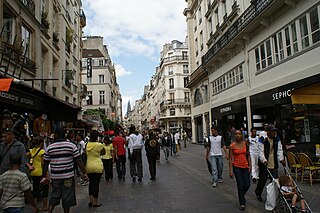
Rue Saint-Denis is one of the oldest streets in Paris. Its route was first laid out in the 1st century by the Romans, and then extended to the north in the Middle Ages. From the Middle Ages to the present day, the street has been notorious as a place of prostitution. Its name derives from it being the historic route to Saint-Denis.

Porte d'Aix is a triumphal arch in Marseille, in the south of France, marking the old entry point to the city on the road from Aix-en-Provence. The classical design by Michel-Robert Penchaud was inspired by the triumphal arches of the Roman Empire. The Porte d’Aix was initially conceived in 1784 to honour Louis XVI and to commemorate the Peace of Paris (1783) that ended the American Revolutionary War. Following the restoration of the Bourbon monarchy in 1814-15, the project was resumed in 1823, now to commemorate French victories in the Spanish Expedition, notably at the Battle of Trocadero, August 31, 1823. It was eventually completed in 1839, with a more general theme of victory.
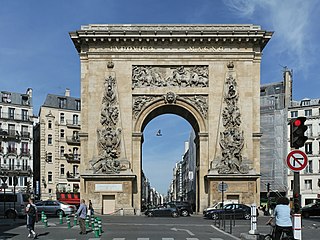
The Porte Saint-Denis is a Parisian monument located in the 10th arrondissement, at the site of one of the gates of the Wall of Charles V, one of Paris' former city walls. It is located at the crossing of the Rue Saint-Denis continued by the Rue du Faubourg Saint-Denis, with the Boulevard de Bonne-Nouvelle and the Boulevard Saint-Denis.

The Boulevards of Paris are boulevards which form an important part of the urban landscape of Paris. The boulevards were constructed in several phases by central government initiative as infrastructure improvements, but are very much associated with strolling and leisurely enjoyment in the minds of Parisians.

The Place de la Nation is a circle on the eastern side of Paris, between Place de la Bastille and the Bois de Vincennes, on the border of the 11th and 12th arrondissements.

The Walls of Paris refers to the city walls that surrounded Paris, France, as it grew from ancient times until the 20th century, built primarily to defend the city but also for administrative reasons. Several successive city walls were built over the centuries, either adding to existing walls or replacing demolished ones, through 1846, when construction of the Thiers wall was completed. The city walls of Paris include:
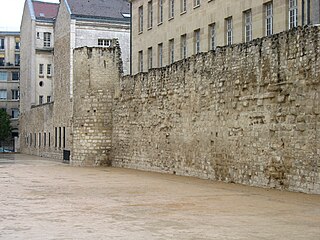
The Wall of Philip Augustus is the oldest city wall of Paris (France) whose plan is accurately known. Partially integrated into buildings, more traces of it remain than of the later fortifications.
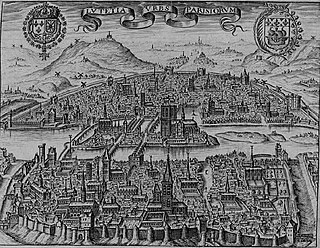
The wall of Charles V, built from 1356 to 1383 is one of the city walls of Paris. It was built on the right bank of the river Seine outside the wall of Philippe Auguste. In the 1640s, the western part of the wall of Charles V was demolished and replaced by the larger Louis XIII wall, with the demolished material reused for the new wall. This new enclosure (enceinte) was completely destroyed in the 1670s and was replaced by the Grands Boulevards.

The Fountains in Paris originally provided drinking water for city residents, and now are decorative features in the city's squares and parks. Paris has more than two hundred fountains, the oldest dating back to the 16th century. It also has more than one hundred Wallace drinking fountains. Most of the fountains are the property of the municipality.

The Porte Saint-Antoine was one of the gates of Paris. There were two gates named the Porte Saint-Antoine, both now demolished, of which the best known was that guarded by the Bastille, on the site now occupied by the start of Rue de la Bastille in the 4th arrondissement of Paris.

Simon Vollant was a 17th-century French engineer, entrepreneur and architect ennobled in 1685.
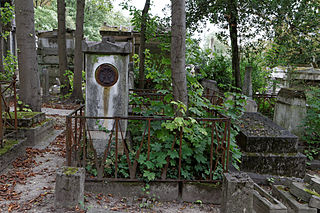
Jacques Cellerier (1742–1814) was a French architect in the neoclassical style whose buildings can be seen mainly in Paris and Dijon.

The Arc Héré or Porte Héré is a triumphal arch located in the city of Nancy, France, on the north side of the Place Stanislas. It was designed by Emmanuel Héré de Corny to honor the French king Louis XV and was built between 1752 and 1755. Its architecture is inspired by the Arch of Septimius Severus in Rome. The Arc replaced an older royal gate constructed under the rule of Louis XIV; three bas reliefs from the old gate are featured on the Arc.
This page is based on this
Wikipedia article Text is available under the
CC BY-SA 4.0 license; additional terms may apply.
Images, videos and audio are available under their respective licenses.




















